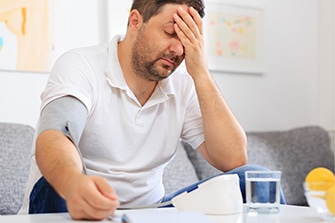Vicodin Withdrawal: Symptoms, Timeline and Treatment
What is Vicodin and What Does It Do?
According to MedicineNet, Vicodin is a combination of Hydrocodone and Acetaminophen. Hydrocodone is a narcotic pain-reliever and a cough suppressant, similar to codeine. Hydrocodone blocks the receptors on nerve cells in the brain that give rise to the sensation of pain. Acetaminophen is a non-narcotic pain reliever and fever reducer. Acetaminophen works by elevating the threshold to pain. Essentially, in order for pain to be felt, s greater stimulation of the nerves responsible for the sensation of pain is necessary. It reduces fever through its action on the temperature-regulating center of the brain. The FDA approved Vicodin in January 1983.
Vicodin can be effective if taken as prescribed in aiding individuals with pain relief after a serious injury, surgery or chemotherapy. However, it is dangerous and should only be taken under the supervision of a medical professional. As a depressant, abuse of Vicodin can slow breathing and heart rate which could lead to coma or death.
Vicodin Withdrawal Symptoms
Vicodin is habit-forming, meaning physical and psychological dependence can occur. When an individual is prescribed Vicodin, it is very important to be slowly weaned off the medication rather than stopping use suddenly. This is because withdrawal symptoms can occur, and these symptoms can be greater for those who have formed an addiction versus those taking Vicodin for pain management.
Psychological Vicodin withdrawal symptoms include:
- Anxiety
- Irritability
- Mood swings
- Drug cravings
Physical symptoms include:
- Nausea
- Vomiting
- Diarrhea
- Goosebumps
- Muscle aches
- Muscle cramps
- Flu-like symptoms
- Insomnia
- Changes in appetite
How Long Does Vicodin Withdrawal Last?
The withdrawal process is different for everyone. The sooner an individual is able to get treatment for Vicodin addiction, the easier their body will be able to handle withdrawal and “re-wire” back to its natural state. The average amount of time it takes for physical Vicodin withdrawal symptoms to subside is about one to two weeks. However, psychological symptoms can remain for months or years, making ongoing aftercare an important part of the recovery process.
Factors That Impact Vicodin Withdrawal Symptoms and Timeline
Much like other forms of illnesses, Vicodin addiction and Vicodin withdrawal is an individual process. Some individuals may experience more severe symptoms than others, and this depends on the length of the addiction, the tolerance level of the individual and the dosage that has been taken over time.
- Length of addiction. An individual who has been taking Vicodin as prescribed for a few weeks will have significantly more tolerable withdrawal symptoms than someone who has been addicted for a long period of time.
- Tolerance level. The more an individual takes Vicodin, the more it will take for them to experience a “high”. They may begin to take Vicodin more frequently to achieve a high. For an individual who has built tolerance, their withdrawal symptoms can be more severe than someone who has not.
- Dosage. If two individuals have been taking Vicodin – one as prescribed, and one who formed an addiction taking more than prescribed – and stopped at the same time, the individual who took higher doses will experience more severe withdrawal symptoms.
Medication-assisted Detox and Treatment
The Vicodin withdrawal process can be uncomfortable. That is why Cliffside Malibu offers medication-assisted detox with an on-site Addictionologist. With the help of medications to aid individuals through the withdrawal process, they are able to detox safely and more clearly focus on behavioral therapy to stay sober.
In medication-assisted treatment, individuals are able to slowly taper off Vicodin to minimize withdrawal symptoms and allow the body time to adjust. The road to recovery isn’t one paved path for everyone; while some individuals may need to quit substances immediately, others may need to slowly taper off in the best interest of their health and long-term sobriety.
Holistic Therapy
Another way for individuals to treat uncomfortable Vicodin withdrawal symptoms is to practice some forms of holistic therapy. Keeping stress levels low will greatly help through the withdrawal process as well as through the challenging first stages of early recovery.
Holistic therapy includes:
- Exercise, such as yoga or running to keep stress and anxiety low
Balanced nutrition to give the body the fuel it needs during withdrawal - Massage therapy to help with any aches and pains associated with Vicodin withdrawal, as well as a way to keep stress and anxiety at bay and help with sleep
- Mindfulness and meditation to help with stress, anxiety and drug cravings
- Acupuncture to help with aches and pains
About Cliffside Malibu
Since Vicodin is an opioid, it runs the risk of addiction like all other opioids. Addiction to Vicodin is deadly, but luckily, it is a treatable condition. Experiencing Vicodin withdrawal can be unpleasant; the safest and most comfortable way to experience it is under the care of medical professionals.
Since no two addictions are the same, Cliffside Malibu offers an individualized treatment plan for each and every client. We are committed to providing the best care possible through a continuum of care, including medically supervised detox, residential treatment, day treatment, and outpatient services. In addition to evidence-based treatment, our program also includes family therapy and holistic therapy. Whether an individual is suffering from substance abuse and/or alcohol addiction, our programs are designed and structured to be a supportive environment in order to maintain sobriety.
In addition to world-class treatment, Cliffside Malibu offers luxury accommodations, a serene environment, five-star dining, and plentiful amenities. We understand that addiction treatment is a rigorous process. Therefore, we provide for your comfort and relaxation at every turn, allowing you to rejuvenate, to meet the demands of treatment with your greatest energy and attention.
For more information on Cliffside Malibu, visit cliffsidemalibu.com
